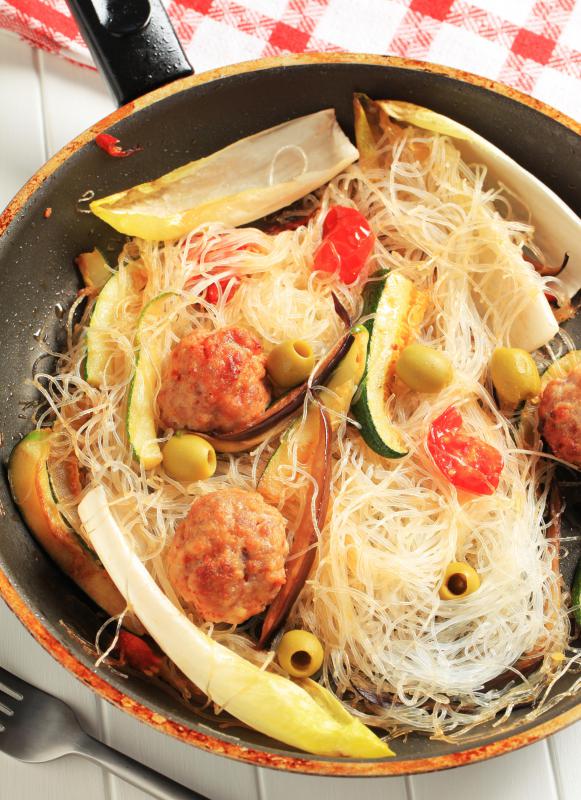At WiseGEEK, we're committed to delivering accurate, trustworthy information. Our expert-authored content is rigorously fact-checked and sourced from credible authorities. Discover how we uphold the highest standards in providing you with reliable knowledge.
What Are the Best Tips for Serving Cellophane Noodles?
Before serving cellophane noodles, soak them in hot water to create softness. The soft noodles can be used for a "bed" for many different types of stir-fries as well as in spring rolls and soups. Deep-fried cellophane noodles have a completely different, very crunchy, texture that can be wonderful for both stir-fries and salads.
An easy way to serve a tropical salad with cellophane or "glass" noodles is to place them into a bowl on the table after they're deep-fried. Other ingredients such as shredded raw cabbage, matchstick carrots, thinly sliced chicken, pineapple chunks and cashews can also be placed in separate bowls on the table. A dressing made from soy sauce, orange juice, sesame oil, ginger and honey can be served along with the bowls of ingredients. Diners can then help themselves to make their own salads layered in individual salad bowls in the order they prefer.

A crunchy stir-fry is ideal to serve on a bed of deep-fried cellophane noodles. Since the noodles are crisp, almonds or cashews added on top just before serving can enhance the crunchy appeal of the dish. A bed of the deep-fried noodles can be especially delicious with batter-coated, cooked meat such as pork in a sweet and sour sauce. The contrast of the crunchy noodles and coating against the softness of the meat and sauce can be pleasing to the palate.

Soft cellophane noodles are ideal for soups and spring rolls since a crunchy texture isn't desired in these dishes. The outer coating of a spring roll should be crisp, but the noodles and vegetable mixture within must be tender to eat. In soups, the vegetables and other ingredients shouldn't be mushy, but tender and firm. Soft cellophane or glass noodles can perfectly complement the soup ingredients and take on the seasonings and broth flavors.

When serving a main dish on a bed of soft cellophane or glass noodles, seafood such as shrimp can be an especially nice addition. Minced garlic and ginger can make good flavor enhancers. Steamed bok choy tends to combine well with the texture of cellophane noodles. Flank steak, sliced against the grain and marinated, can make a tender and delicious alternative to shrimp to serve over the noodles. Mushrooms, sauteed or stir-fried to a rich, smoky finish, tend to work well with the noodles and meat or seafood.
AS FEATURED ON:
AS FEATURED ON:














Discuss this Article
Post your comments